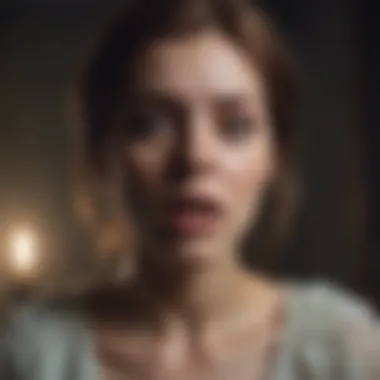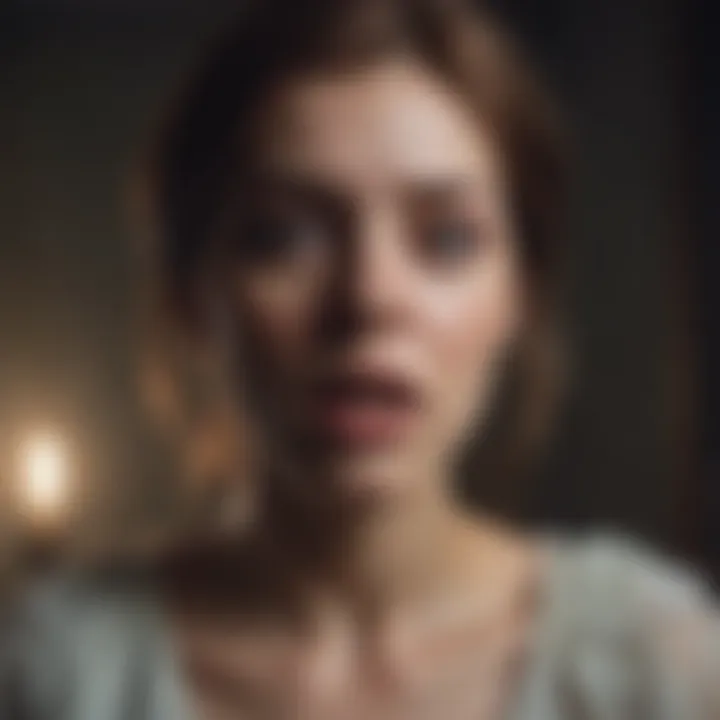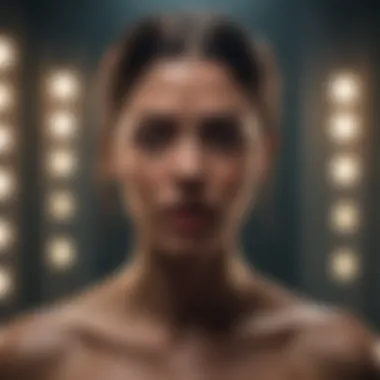Essential Horror Movies That Define the Genre


Intro
Horror cinema holds an esteemed place in the hearts of film enthusiasts. Its power to evoke a range of emotions—from dread to fascination—makes it a compelling genre. The impact of horror films goes beyond mere thrills; they often provide a canvas for deeper cultural reflections and societal commentary. This article aims to navigate through a selection of essential horror films that have left an indelible mark on the genre, addressing their thematic richness and unique storytelling techniques.
Exploring the diverse landscape of horror, we will delve into notable films, examining how they reflect human fears and anxieties. The goal is to guide the reader toward a nuanced understanding of these films, enhancing their appreciation for the artistry involved. Each selected film offers profound insights into the human condition and societal issues, revealing why they remain significant in both cinephile circles and the wider cultural context.
Here, we will provide an overview of key themes and trends that define excellent horror movies, allowing readers to engage with the material on a much deeper level than just surface enjoyment. Through this journey, we will highlight not only the unsettling aspects of horror but also celebrate the creativity and craftsmanship that elevate these narratives beyond ordinary storytelling.
In subsequent sections, we will uncover some of the most impactful horror films and analyze their contributions to the genre. Understanding these elements helps us appreciate the role of horror in our cultural landscape.
Intro to Horror Cinema
The realm of horror cinema is often misunderstood. It is not merely a collection of scares and frights. Instead, horror films serve as a mirror reflecting our deepest fears and societal anxieties. This genre offers a unique commentary on human nature and the world we inhabit. Exploring the significance of horror cinema is essential for appreciating its intricate layers that extend beyond entertainment.
Defining the Horror Genre
Horror, as a genre, encompasses a wide array of styles and approaches. It can be defined through certain core elements such as fear, dread, and the supernatural. Key characteristics often include a portrayal of grotesque scenarios, psychological tension, and moral complexities. However, defining horror is not strictly about its thematic elements. It is also about the emotional responses it invokes in its audience.
The genre often blurs the lines between reality and illusion, prompting viewers to confront uncomfortable truths. For example, films like Get Out challenge social norms while embedding horror within real-life issues. Thus, understanding horror requires an awareness of its multidimensional aspects, as it often intersects with other genres.
Cultural Significance of Horror Movies
The cultural impact of horror films is profound. They resonate with audiences on various levels, often reflecting societal fears. Consider how periods of unrest or change have influenced the stories told in horror. In the 1950s, the fear of nuclear annihilation was prevalent. Movies like Godzilla embodied this fear, using monsters to symbolize the destruction humans could wreak upon themselves.
Horror also gives voice to marginalized groups. For instance, A Nightmare on Elm Street portrayed a diverse array of characters facing a common adversary. These narratives broaden the understanding of human experience, challenging stereotypes and fostering inclusivity.
"Horror films often encapsulate the very essence of societal fears, driving discussions about morality, identity, and what it means to be human."
Understanding the cultural significance of horror films uncovers their deeper meanings. It allows viewers to engage in critical discussions about the themes presented, ultimately leading to a richer viewing experience. As horror cinema evolves, it continues to uncover profound insights into the human condition.
Historical Context of Horror Films
The historical context of horror films serves as a crucial framework for understanding its evolution and significance in cinema. Horror has not only thrived on audience fears but has also evolved alongside societal changes, reflecting cultural anxieties and technological advancements. The period in which a film is produced can greatly influence its themes, styles, and the type of horror it portrays. By examining horror's past, one can gain insight into enduring motifs and the genre's capacity to reinvent itself in line with shifting societal norms.
The exploration of historical context allows viewers and critics to appreciate the artistry and intent behind each film. It helps contextualize the genre within broader cultural movements and trends. For instance, the horror films of the 1970s often echoed the tumultuous sociopolitical landscape, while contemporary horror critiques consumerism and technology. By understanding these layers, audiences are better equipped to analyze and appreciate the powerful narratives woven throughout horror cinema.
Early Classics of Horror
The period of early horror classics laid the foundation for the genre, introducing iconic themes and archetypes still resonant today. Films such as Nosferatu and Frankenstein not only scared audiences but also explored deep existential themes and human fears. Nosferatu (1922), directed by F.W. Murnau, was pivotal in establishing the atmosphere of dread that characterizes horror cinema. The expressionist style and unique cinematography made it a model for future horror films.
Frankenstein (1931), directed by James Whale, advanced the genre by marrying science fiction with horror. It presented the cautionary tale of unchecked ambition and the consequences of playing God, encapsulating the fears surrounding technological progress. Both films are crucial for understanding the thematic depth of horror and its ability to engage with profound psychological issues.
During this time, horror was often presented through silent films, requiring a strong visual language to evoke emotion. The use of shadows, lighting, and makeup defined the aesthetic of early horror, creating an atmosphere that remains influential today. These classics serve as significant cultural artifacts, illustrating how early filmmakers grappled with the human condition and societal fears through thrilling narratives.
Influential Movements in Horror
As horror films evolved, various movements began to push the genre’s boundaries. The rise of Universal Studios in the 1930s introduced a wave of horror that included Dracula and The Invisible Man. These films not only provided entertainment but also tackled themes of isolation, fear of the unknown, and societal judgment.
The 1960s brought about a significant transformation with Italian Giallo films, characterized by their blend of horror with crime and psychological thriller elements. Directors like Dario Argento popularized vivid visuals paired with intense soundtracks, creating an immersive experience that appealed to a more sophisticated audience.
Another notable movement is the emergence of psychological horror in the late 20th century. Films such as Psycho by Alfred Hitchcock introduced the idea that horror stems from within the mind rather than solely from external monsters. This shift emphasized character development and complex motivations, appealing to viewers' intellect and emotional depth.


In summary, the historical context of horror films is rich with innovations and cultural reflections. Understanding early classics and influential movements enriches our viewing experience, highlighting how horror not only entertains but also provokes thought and discussion about deeper societal issues.
Must-Watch Horror Films
The genre of horror is vast and multifaceted, showcasing a plethora of creative narratives that evoke deep emotional responses. Identifying must-watch horror films is crucial, as these selections often redefine the boundaries of storytelling, offering fresh perspectives on fear and psychological stress. A well-curated list serves several purposes: it highlights thematic depth, showcases innovative filmmaking techniques, and provides insight into the cultural implications of horror cinema. Such films reflect societal fears, merging entertainment with commentary on broader issues.
Contemporary Horror Masterpieces
In recent years, contemporary horror has evolved significantly. Filmmakers like Jordan Peele, Ari Aster, and Robert Eggers have pushed the envelope, intertwining social commentary with horror elements. These masterworks often address relevant themes, such as race, trauma, and mental health, providing viewers with more than just scares.
- Get Out (2017) - Peele’s film disrupts traditional horror by intricately weaving racial tensions into its narrative, presenting a powerful examination of exploitation and identity.
- Hereditary (2018) - A haunting portrayal of grief and familial dysfunction, Aster's film explores the concept of inherited trauma, creating an unsettling atmosphere that lingers long after viewing.
- The Lighthouse (2019) - Eggers uses isolation to craft a psychological descent into madness, focusing on themes of masculinity and existential dread. The film's black-and-white aesthetic enhances its eerie qualities.
Timeless Classics Revisited
Timeless classics are cornerstones of the horror genre. These films have not only endured the test of time but have also laid the foundation for future horror narratives. Their influence continues to be felt across generations.
- Psycho (1960) - Alfred Hitchcock's cinematic masterpiece revolutionized horror with its psychological depth and shocking twists. The infamous shower scene remains a symbol of fear.
- The Exorcist (1973) - Often considered one of the scariest films of all time, it tackles themes of faith, possession, and maternal struggle. The impact of its chilling visuals is still noted today.
- Halloween (1978) - John Carpenter’s film introduced the concept of the slasher genre, creating a blueprint for many horror films that followed. Its minimalist score and iconic character of Michael Myers are unforgettable.
International Horror Cinema
Exploration of international horror films opens doors to diverse storytelling methods and cultural fears. Genres vary significantly across different countries, illuminating the unique ways societies process fear.
- Ringu (1998) - This Japanese film popularized the J-horror genre, introducing audiences to a new type of psychological horror with its eerie ghost story. It paved the way for remakes in Western cinema, expanding its influence.
- Let the Right One In (2008) - A Swedish take on the vampire myth, this film explores themes of childhood loneliness and companionship in a haunting, yet tender manner.
- A Girl Walks Home Alone at Night (2014) - An Iranian vampire western, this film subverts traditional horror narratives, combining feminist themes with a unique visual style that captivates.
The exploration of horror films unveils humanity's deep-seated fears, reflecting not just fictional scares but real-life anxieties and societal issues.
In summary, must-watch horror films vary from contemporary masterpieces to timeless classics and international gems. These films collectively offer an insightful exploration into the human psyche and societal norms. They serve not only to frighten but also to provoke thought, allowing audiences to reflect on their own realities while engaging with the genre.
Subgenres of Horror
The exploration of horror films naturally leads us to the concept of subgenres. Understanding these subgenres is essential to appreciating the remarkable diversity within horror cinema. Each subgenre provides unique experiences, storytelling techniques, and thematic focus that resonate differently with audiences. This article will examine how subgenres enrich horror as an art form, allowing for creative experimentation and nuanced commentary on societal fears.
Psychological Horror
Psychological horror delves into the complex nature of the human mind. Rather than relying on graphic violence and external threats, this subgenre plays with mental states and internal fears. It often centers on characters' psychological struggles, leading to a slow build-up of tension and unease. Filmmakers like Darren Aronofsky, particularly in Black Swan, craft a narrative that blurs the lines between reality and delusion. This method challenges viewers to confront the fragility of their own perceptions. The emotional depth found in these stories can linger with the audience long after viewing, making it a profound subgenre.
Supernatural Horror
Supernatural horror taps into the unseen world, introducing elements like ghosts, demons, and otherworldly forces. This subgenre allows filmmakers to explore themes of existential dread and the unknown. Movies such as The Conjuring and Hereditary showcase how traditional beliefs about the supernatural can reflect modern anxieties around family, faith, and mortality. The incorporation of folklore and myth adds layers to the narrative, often prompting audiences to ponder the intersection of reality and belief. This subgenre appeals to those fascinated by the mysteries beyond human comprehension.
Slasher Films
Slasher films represent a distinct branch of horror, marked by a formula of stalking and high body counts, often featuring a relentless killer. The genre emerged prominently in the late 1970s and 1980s, with films like Halloween and A Nightmare on Elm Street. These movies frequently involve young adults in peril, tapping into adolescent fears and rebellion. While slasher films may appear superficial at first, they often serve as social critiques, revealing underlying societal issues, such as gender dynamics and consumerism. The memorability of their iconic villains lingers in popular culture, making slasher films a significant contributor to the horror landscape.
Eco-Horror and Social Commentary
Eco-horror combines traditional horror elements with environmental themes, reflecting societal concerns about nature and humanity’s role in ecological disaster. Films like The Ruins and Annihilation demonstrate how nature can turn against humanity, posing existential threats. This subgenre prompts viewers to contemplate the consequences of environmental negligence. In addition, it serves a broader function of social commentary, questioning human actions and their repercussions on the planet. As global climate crises escalate, eco-horror remains relevant and engages audiences on urgent issues that affect all of us.
The exploration of various horror subgenres reveals the way they reflect a spectrum of fears — from psychological and supernatural to ecological, enhancing our understanding of how horror films resonate socially.
Each horror subgenre offers a distinct lens through which to perceive societal fears and human experiences. From the unsettling depths of psychological horror to the urgent commentary found in eco-horror, these categories underscore the genre’s richness and complexity. They encourage audiences to confront fears in a controlled environment, showcasing the essential role of horror in cinema.
Elements of Effective Horror Storytelling


In the realm of horror cinema, certain elements serve as the backbone of effective storytelling, drawing audiences into a world of fear and suspense. Understanding these components helps dissect what truly makes a horror film impactful. This section will discuss the importance of creating atmosphere and tension, character development, and the role of sound and music in horror films. Each of these elements contributes significantly to the viewer's experience and emotional response.
Creating Atmosphere and Tension
Atmosphere is crucial in horror films. It shapes the viewer's emotional landscape, setting the stage for fear to unfold. A well-crafted atmosphere can invoke dread before the first scare occurs. Directors use lighting, color palettes, and set designs to build this intense ambiance. For instance, dimly lit rooms can heighten feelings of claustrophobia.
Tension is built gradually. It often emerges from the anticipation of what might happen rather than from what actually occurs. The pacing of the narrative is important here. Long, drawn-out scenes that leave characters vulnerable create uncertainty. A film like The Witch, for example, excels in this method of storytelling, leaving audiences on edge through its slow burn narrative.
"The tension in a horror film is best when it makes you question your own perception of reality."
Effective tension can manifest in many ways, such as through foreshadowing or the use of silence. Jump scares can be effective but are often less impactful without the underlying atmosphere to support them.
Character Development in Horror
Character development is often overlooked in horror films. Strong characters make the story relatable, causing the audience to care about their fates. This is particularly effective when the viewers find themselves connecting with characters on an emotional level. For example, in Hereditary, the audience is drawn into the family's intricate dynamics. This connection amplifies the horror as the narrative unfolds.
The protagonist's journey usually aligns with the horror elements. A descent into madness or a fight for survival forms a central theme. Characters who exhibit growth in the face of terror can leave a lasting impression. An iconic example is Sally Hardesty from The Texas Chain Saw Massacre. Her transformation from frightened victim to a determined survivor creates a compelling narrative arc.
The Role of Sound and Music
Sound and music are pivotal in horror, often heightening the emotional impact of a film. The auditory experience can amplify a viewer's fear and anticipation. An effective score will build tension before significant moments, using crescendo and dissonance to manipulate feelings.
Silent moments can be as powerful as loud sounds. The absence of sound can create unease, making the audience aware that something significant is about to happen. Films such as A Quiet Place illustrate this masterfully, relying on silence to amplify the sheer terror of vulnerability.
In addition to music, sound effects play an important role. Subtle noises like whispers, scratches, or creaks can enhance the atmosphere, making viewers aware of their surroundings—both on and off-screen. Cinematic techniques that combine these auditory elements contribute to a rich, immersive horror experience.
In summary, the elements of effective storytelling in horror films are interconnected. Atmosphere and tension, character development, and sound and music work together to create a unique viewer experience. Understanding these elements is essential for appreciating the artistry behind horror cinema.
The Impact of Technology on Horror Films
The evolution of technology has played a crucial role in shaping the horror genre. As filmmakers gain access to innovative techniques and tools, the way stories are told has transformed. This impact is evident in both the creation and distribution of horror films. In this section, we will delve into how advancements in special effects and the rise of streaming platforms have redefined audience experiences and expectations.
Advancements in Special Effects
Special effects have always been a central element of horror films. Advances in technology have allowed filmmakers to push the boundaries of what can be visually represented on screen. From practical effects using prosthetics in films like The Thing to CGI innovations seen in It Follows, the ability to create realistic horror has significantly improved.
These advancements also promote creativity. Filmmakers can now depict fears of the unknown or construct nightmarish worlds that were previously impossible. For instance, in Hereditary, the use of visual effects contributes to the film’s unsettling atmosphere, serving to enhance the emotional responses of the audience. Furthermore, this integration of technology leads to greater immersion, drawing viewers into the narrative significantly more than earlier techniques could.
"Special effects serve to heighten emotional responses, confronting the audience with tangible fears."
Streaming and Accessibility
The rise of streaming services, such as Netflix and Shudder, has transformed how horror films are delivered to audiences. They offer a wide array of horror films, from mainstream blockbusters to independent and classic gems. This access enables viewers to explore and discover new titles beyond conventional theaters.
Streaming has democratized horror cinema and fostered community. Viewers can connect over their shared interests in niche subgenres, sharing recommendations and critiques. The impact extends to the films featured prominently on these platforms, often highlighting films with unique voices or perspectives that might have gone unnoticed otherwise. As a result, audiences can now easily find content aligning with their preferences.
The convenience and accessibility of streaming platforms have also influenced viewing habits. Audiences can watch films at their own pace and in the comfort of their homes, which may lead to an evening filled with spine-tingling scares.
Horror Movie Festivals and Critiques
Horror movie festivals serve as vital platforms for indie filmmakers to showcase their work. These events often highlight the diversity within the horror genre, celebrating narratives that may not find a place in mainstream cinema. Festivals like Fantasia International Film Festival, Frameline, and the Screamfest Horror Film Festival draw audiences who appreciate the unique storytelling that often pushes boundaries.
Attending festivals provides insights into emerging talent and innovative trends in the genre. Viewers can engage directly with filmmakers, ask questions, and discuss the themes present in their films. This interaction also fosters a community, where enthusiasts can share their views with others who have similar tastes.
Moreover, horror festivals are essential for the growth of independent cinema. Many successful horror films have debuted at festivals. Films that gain critical acclaim in these environments can secure wider distribution deals afterward. The focus on independent horror not only champions creativity but also provides more varied content for audiences.
In addition, the discussions and panels often held at these festivals can deepen a viewer's understanding of what makes horror effective. Topics may include the psychological dimensions of fear, the use of special effects, and how horror reflects societal issues. The critiques that arise from viewing these independent films can lead to broader discussions about the genre's evolution and its cultural significance.
"Cinema is a mirror by which we can see ourselves. Horror films reveal our fears and anxieties about society."
Celebrating Indie Horror at Festivals
Indie horror films often stand out during festivals due to their unique narratives and experimental storytelling. This genre provides a platform for voices that diverge from mainstream cinema. Movies such as Hereditary and The Witch originated from indie roots, presenting fresh perspectives on horror conventions.
Festival-goers often find that indie horror blends innovation with deeper thematic exploration. Instead of relying solely on jump scares or predictable plots, many indie films focus on character development and atmosphere. This allows for creativity to flow freely, leading to original ideas that engage audiences on multiple levels.
Key elements celebrated include:
- Diverse storytelling: Indie films often cover topics such as mental health, social injustice, or cultural issues.
- Unique visual styles: Aesthetic choices can vary widely, often setting the tone effectively through minimal budgets.
- Character depth: Indie horror challenges viewers to connect emotionally with characters, making the horror more palpable.
Critical Reception and Analysis
Critical reception plays an important role in shaping the conversation around horror films. Evaluations from critics influence how audiences perceive films and impact box office success. Through reviews, critics can highlight cinematography, narrative structure, and thematic weight.
Analysis of horror can also unpack cultural commentary embedded within the films. For example, movies such as Get Out reflect on race relations and societal fears. Critics often explore how these films challenge norms and provoke thought.
Key considerations in critical analysis include:
- Themes and motifs: Many horror films carry underlying messages about society’s fears and anxieties.
- Cinematic techniques: The analysis of camera angles, lighting, and sound design can reveal how fear is constructed and delivered to the audience.
- Cultural context: Understanding how the times in which a film is made influence its storytelling.
Assessing horror through these lenses helps delineate its value beyond mere entertainment. It encourages a richer understanding of both the genre and the societal issues it mirrors.
The Future of Horror Cinema
The future of horror cinema is an essential part of understanding the genre's evolution. As societal anxieties continue to shift, horror films often reflect these changes, providing insight into cultural fears and hopes. In this article, we will explore emerging trends and innovations, as well as the role of audience reception in shaping what horror will look like moving forward.
Emerging Trends and Innovations
In recent years, horror has seen a significant transformation in its approach to storytelling. One major trend is the inclusion of diverse voices and perspectives. Filmmakers from various backgrounds are stepping into the horror space, offering fresh narratives. These new stories often challenge traditional horror tropes and create engaging metaphors for real-world issues. For example, films like Get Out by Jordan Peele not only entertain but also provoke thought about race relations.
Another notable trend is the utilization of technology to enhance storytelling. The rise of virtual reality (VR) and augmented reality (AR) has opened new avenues for immersive horror experiences. These technologies allow audiences to engage with narratives in a more personal and visceral way. Additionally, advancements in special effects and CGI have enabled creators to visualize concepts that were once unachievable. Such innovations enrich the viewer’s experience, making horror more potent and relatable.
Furthermore, the streaming revolution has increased accessibility to horror. Audiences can now explore niche films that might not have found a place in traditional cinemas. Platforms like Netflix and Shudder have dedicated sections for horror, allowing fans to discover small independent films alongside big-budget productions.
"Horror constantly evolves, mirroring society's shifting fears, desires, and realities."
The Role of Audience Reception
Audience reception is a crucial element in determining the future trajectory of horror cinema. As viewers become more vocal and influential, their preferences shape what is produced. Social media platforms like Reddit and Facebook have given fans a voice, creating communities that discuss and critique horror films. These online discussions can elevate the profile of lesser-known films and influence mainstream trends.
Moreover, audiences today are increasingly seeking films that challenge norms. Viewers want complex characters and stories that go beyond mere scares. The appetite for psychological and social commentary within horror is growing. As this demand continues, filmmakers will likely adapt to meet these expectations.
Another interesting factor is the globalization of horror. With international films gaining popularity, audiences are exposed to different cultural approaches to fear. This cross-pollination of ideas contributes to a wider array of horror narratives. Films from countries such as Japan, South Korea, and Spain have made significant impacts and will inspire future projects.
Ending
In summarizing the significance of the horror genre, it becomes evident that its intricate narratives and thematic elements are far more than mere entertainment. Horror films provide a lens through which we can explore our deepest fears and societal anxieties. They resonate because they often reflect real-world issues, creating a connection between the viewer and the unsettling themes on screen.
Reflections on the Horror Genre
The horror genre, while often dismissed as just a platform for scares and thrills, has evolved significantly over the decades. It challenges audiences not only to embrace fear but also to confront uncomfortable truths. Many women, for instance, find empowerment in viewing horror films; they appreciate strong female protagonists who navigate perilous situations and emerge resilient. This aspect can serve as both an individual's catharsis and a collective reflection on gender dynamics.
Critically, horror movies cover a wide spectrum of human experience. They tackle issues such as mental health, social injustice, and existential dread. Films like Get Out and Hereditary showcase how horror can delve into race and family trauma respectively, illustrating the versatility of the genre. Thus, the value of horror cinema extends beyond jump scares; it serves to provoke thought and discussion.
Moreover, horror films encourage community and dialogue. Whether through hosting watch parties or participating in discussions on platforms like Reddit or Facebook, audiences connect over shared viewing experiences. This social aspect strengthens the impact of these films, pushing viewers to not only absorb their messages but also critique and analyze them alongside others.



